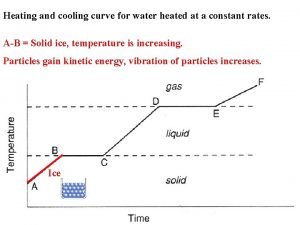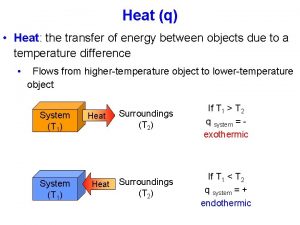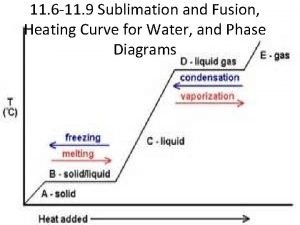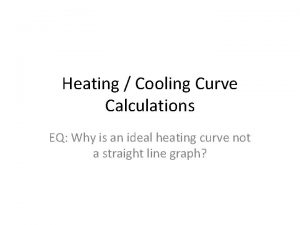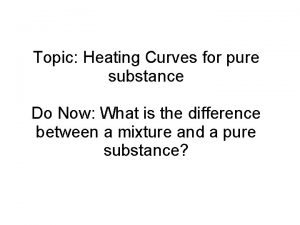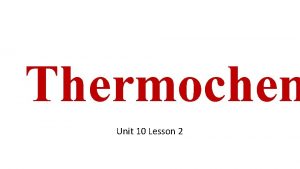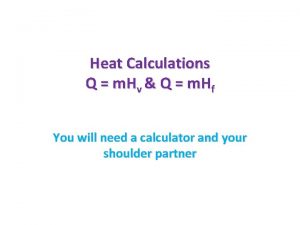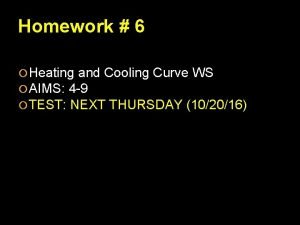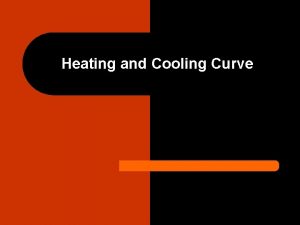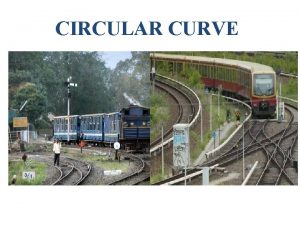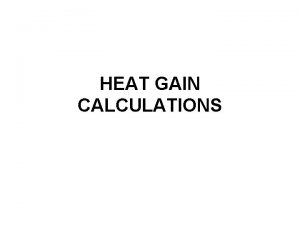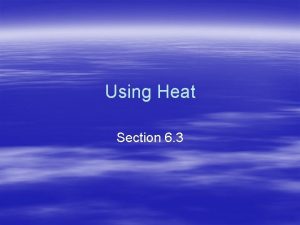HEAT PARTICLE THEORY CHANGES OF STATE Heating Curve











- Slides: 11

HEAT

PARTICLE THEORY & CHANGES OF STATE Heating Curve:

PARTICLE THEORY & CHANGES OF STATE Heating Curve: • A graph showing how a substance’s temperature changes while being heated • The plateaus = when a change of state is occurring • “Hidden Heat" = the energy required to change a substance’s state of matter; the energy is used to “free” particles from their previous state instead of warming the substance → therefore the temperature does not increase for a given amount of time and the graph indicates the plateau • For water (ice to water to steam): → 0°C is the temperature at which ice (solid) begins to melt (and the plateau continues until all is water (liquid) → 100°C is the temperature at which water (liquid) begins to boil (plateau begins)

PARTICLE THEORY & CHANGES OF STATE Cooling Curve: • A graph showing how a substance’s temperature changes while being cooled • The plateaus = when a change of state is occurring • For water (steam to ice): → below 100°C is the temperature at which steam (gas) begins to condense (plateau begins) → below 0°C is the temperature at which water (liquid) begins to freeze (and the plateau continues until all is ice)

HEAT AND CONVECTION Class Demonstration: • A beaker of water with pepper was partially heated on a hot plate (pepper helps to see the movement of the water) Convection Current Demo. MOV • On the heated side (left side): → addition of heat → water particles have more energy → particles move more quickly → have more collisions → particles take up more space → water is less dense → water rises • On non-heated side (right side): → loss of heat → water particles have less energy → particles move more slowly → have less collisions → particles take up less space → water is more dense → water sinks

HEAT AND CONVECTION • Convection = the transfer of heat by the movement of particles from one part of a fluid (liquid or gas) to another • Convection current = the motion of many fluid particles cold dense water sinks – hot less dense water rises

HEAT AND WEATHER PATTERNS Thermals, Winds, Sea Breezes: • The convection current in this case = thermal • As thermals grow in size, drawing more and more cool air in at the bottom, people on the ground detect the flow of air as wind • This wind most likely develops near large bodies of water (lakes, oceans) • Water warms slower than soil, so the air over water tends to be cooler • If the convection current is near a sea or an ocean, the wind that forms = sea breeze • Thermals help large birds (eagles) glide in the air for hours; as warm air rises, birds ride it. If it isn’t strong enough to keep them aloft without effort, or they want to move to a new area, they glide down to the next thermal and start the cycle again

HEAT AND WEATHER PATTERNS Thermals, Winds, Sea Breezes:

HEAT AND WEATHER PATTERNS Large Wind Patterns: • Huge convection currents are created by the sun in Earth’s atmosphere, causing global wind patterns to develop. • One might expect winds at Earth’s surface to blow only from the poles to the equator… however, one factor affecting wind direction is Earth’s motion → Earth spins on its axis once each day → As it spins, the rising and falling air can also start to move in a curved or circular patterns → The result is that air moves in general patterns, but at a local level wind direction and strength are difficult to predict

HEAT AND WEATHER PATTERNS Large Wind Patterns:

HEAT AND WEATHER PATTERNS Large Wind Patterns:


